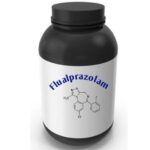Fluorexetamine (FXE): Uses, Benefits, How it Works, Side Effects, Addiction, Legality

Fluorexetamine, often abbreviated as FXE, is a synthetic research chemical that has garnered increasing attention in recent years. This compound belongs to the arylcyclohexylamine class, which is known for its dissociative and psychotropic effects. While FXE is not as well-known as some other dissociative substances like ketamine or PCP, it has gained popularity among researchers and enthusiasts for its unique properties and potential therapeutic applications.
In this article, we will delve into the world of fluorexetamine, examining its history, chemical structure, pharmacology, effects, potential benefits, risks, and legal status. By the end of this article, you should have a better understanding of what fluorexetamine is and why it has become a subject of interest in the realm of research chemicals.
What is Fluorexetamine?
Fluorexetamine is a member of the arylcyclohexylamine class, which includes other well-known dissociative substances like ketamine and 2-MeO-Ketamine. Its chemical structure is quite distinct and includes a fluorene ring, which gives the compound its name. The full IUPAC name for fluorexetamine is 2-(2-fluorophenyl)-2-methylamino-cyclohexanone.
The chemical structure of fluorexetamine makes it a close relative to known dissociatives, and this similarity is the basis for its psychoactive effects. It is important to note that, as a research chemical, fluorexetamine has not undergone extensive scientific research, and its effects are not as well-documented as those of more established substances like ketamine.
History and Origins
The history of fluorexetamine is relatively recent, and it is primarily associated with the world of research chemicals and novel psychoactive substances (NPS). It is believed to have first appeared on the research chemical market in the early 2010s, gaining popularity in online communities dedicated to discussing psychoactive substances.
Fluorexetamine’s origins are unclear, but it is assumed to be a derivative or analog of ketamine, which was initially developed in the 1960s as an anesthetic. The synthesis and distribution of novel psychoactive substances like fluorexetamine are often driven by a desire to circumvent drug regulations and restrictions, resulting in compounds that are not controlled or scheduled.
Legal Status
The legal status of fluorexetamine varies from country to country. Fluorexetamine is currently not explicitly controlled in many parts of the world, including the United States and much of Europe. However, it’s essential to keep in mind that legal regulations regarding novel psychoactive substances can change rapidly. Always consult your local and national laws and regulations to ensure you are in compliance.
Mechanism of Action
The exact mechanism of action of fluorexetamine is not well understood, as there is limited scientific research available. However, like other arylcyclohexylamines, it is believed to primarily affect the N-methyl-D-aspartate (NMDA) receptor system in the brain. These receptors are crucial for functions such as learning, memory, and pain perception.
As a dissociative substance, fluorexetamine likely induces its characteristic effects by blocking NMDA receptors, leading to altered sensory perception and a dissociation of the mind from the body. The precise interactions within the brain and nervous system that lead to the unique effects of fluorexetamine remain a subject of ongoing research.
Effects Fluorexetamine
The effects of fluorexetamine can vary significantly depending on the dosage, individual factors, and the set and setting in which it is used. Commonly reported effects of fluorexetamine include:
- Dissociation: Fluorexetamine is known for its dissociative properties, which can lead to a sense of detachment from one’s body and surroundings. This effect is often described as “out-of-body” or “floating” sensations.
- Altered Perception: Users of fluorexetamine often report changes in sensory perception, including distortions in visual and auditory experiences. Colors may appear more vivid, and sounds may be distorted.
- Euphoria: Some users describe feelings of euphoria and happiness while under the influence of fluorexetamine.
- Sedation: Fluorexetamine can induce sedation and relaxation, making it appealing for those seeking anxiolytic effects.
- Cognitive Effects: Users may experience altered thinking patterns, including introspection and insight. It can also lead to impairments in memory and cognitive functioning.
- Hallucinations: At higher doses, some users may report experiencing visual or auditory hallucinations.
- Duration: The duration of effects typically ranges from 3 to 6 hours, depending on the dose.
It is crucial to emphasize that the effects of fluorexetamine are not fully understood due to the limited research available. Additionally, the lack of regulation and quality control in the production of research chemicals can result in significant variability in the substance’s purity and composition, which can impact the user experience.
Potential Benefits and Applications
Research Interest
Fluorexetamine’s novelty and unique properties have piqued the interest of researchers in various fields, including neuroscience, psychology, and pharmacology. While its potential therapeutic applications remain speculative, its study may offer insights into the NMDA receptor system and its role in various mental health conditions, such as depression and schizophrenia.
Anxiolytic and Antidepressant Effects
Some anecdotal reports suggest that fluorexetamine may have anxiolytic (anxiety-reducing) and antidepressant-like effects. These effects could be of interest to researchers looking for novel treatments for mood and anxiety disorders. However, rigorous clinical trials are necessary to confirm any potential therapeutic benefits.
Exploration of Consciousness
Fluorexetamine, like other dissociative substances, may offer researchers an opportunity to explore altered states of consciousness and their impact on human perception and cognition. This exploration has implications for understanding consciousness itself and its potential variations.
Enhanced Insight
Some users have reported that fluorexetamine enhances introspection and self-reflection. This effect might be of interest to psychotherapists and counselors for its potential use in therapy settings.
It is essential to emphasize that any potential therapeutic benefits of fluorexetamine are speculative, and its use for medical or therapeutic purposes is not supported by scientific evidence at this time.
Risks and Concerns
There are several risk and concerns when it come to the use of fluorexetamine, they include:
- Lack of Research: One of the most significant risks associated with fluorexetamine is the lack of scientific research. The limited understanding of its pharmacology, long-term effects, and safety profile makes it challenging to assess its risks accurately.
- Safety and Dosing: As a research chemical, fluorexetamine is not subject to quality control standards, and users cannot be sure of its purity or dosage accuracy. This lack of consistency can lead to unexpected and potentially dangerous effects, including overdose or adverse reactions.
- Potential for Abuse: Dissociative substances like fluorexetamine can be psychologically addictive. Repeated use can lead to tolerance and dependence, increasing the risk of compulsive use and potential withdrawal symptoms upon cessation.
- Psychological Effects: The dissociative nature of fluorexetamine can lead to intense and potentially unsettling experiences, including dissociation from reality and hallucinations. These effects may be distressing for some users, potentially leading to psychological harm.
- Legal Risks: The legal status of fluorexetamine can change, and it may become controlled or scheduled in various jurisdictions. Possession, distribution, or sale of fluorexetamine may result in legal consequences.
- Health Risks: Like other dissociative substances, fluorexetamine can pose risks to physical and mental health. These risks may include accidents, injuries, or medical complications while under the influence. Long-term use may also have unknown health consequences.
Harm Reduction and Responsible Use
Education
The first step in harm reduction is education. Individuals considering the use of fluorexetamine should seek information from reliable sources and be aware of the risks and potential consequences associated with its use.
Dosage and Testing
If one chooses to use fluorexetamine, it is crucial to start with a low dose and gradually increase it to minimize the risk of adverse effects. Using a test kit to verify the substance’s identity and purity can also reduce the risk of consuming adulterated or mislabeled compounds.
Setting and Company
Using fluorexetamine in a safe and comfortable environment with trusted individuals can reduce the risk of harm. Having a sober and responsible trip-sitter present can be invaluable.
Moderation
Using fluorexetamine in moderation can help reduce the risk of tolerance, dependence, and adverse effects. Avoiding frequent use and high doses is essential.
Legal Compliance
Always be aware of and adhere to local and national laws and regulations regarding the possession and use of fluorexetamine or any other psychoactive substances.
Conclusion
Fluorexetamine is a relatively new and uncharted compound in the world of research chemicals and novel psychoactive substances. While its unique properties and potential therapeutic applications have sparked interest in the scientific community, it is crucial to approach fluorexetamine with caution due to the lack of comprehensive research on its effects and safety profile.
As with any psychoactive substance, responsible use and harm reduction principles should guide its exploration. Individuals who choose to engage with fluorexetamine should prioritize safety, education, and moderation to minimize potential risks and adverse outcomes. Additionally, it is essential to stay updated on the ever-changing legal status of such substances and comply with the laws of your jurisdiction.
Research on fluorexetamine and other novel psychoactive substances should continue, as it may yield valuable insights into the brain and consciousness. However, until more is known about the compound, it remains a substance of significant concern and uncertainty. As the field of psychopharmacology evolves, further exploration of substances like fluorexetamine will contribute to our understanding of the human mind and the potential applications for the treatment of various mental health conditions.





